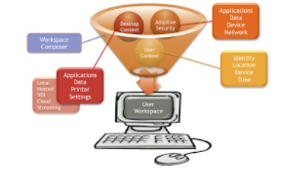
User Virtualisation
User virtualisation refers to the independent management of all aspects of the user on the desktop environment. It decouples a user's profile, settings and data from the operating system and stores this information in a centralised data share, either in a data center or in the cloud. Reducing the cost of managment in Medium to large business' and speeding up the user experiences.
Why user Virtualisation?
User virtualisation offers IT administrators more control, it makes remote management easier and improves the overall experience for end-users.
Think about how you treat your users' workspaces. When a problem occurs with their desktops or laptops, what do you do? Do you "rebuild" the computer to return it to a base configuration? When you're
forced to do that rebuild, do you save their personal items? Is that preservation a painful process, involving manually locating their personal data and uploading it to a remote file server?
Expand this situation beyond just the simple desktop. Do users' workspaces automatically transfer to their laptops when they go out on the road? Are they present when users connect to a Remote
application or a published desktop via Remote Desktop Services? Do the workspaces synchronise themselves into their virtual desktop infrastructure (VDI)-hosted virtual desktops?
For most of us, the unfortunate answer is no. Today's technologies with Windows profiles give IT administrators a limited set of tools for maintaining a user's access mechanisms on roaming
workspaces. Users find themselves repeatedly wasting productive time simply getting their workspaces arranged to their liking.
Personality and Control
The primary problem here is that the combination of local and roaming profiles no longer serves the needs of today's business environment. That's why third-party companies are creating solutions for
managing user states. Different than Windows profiles, these tools take a vastly different approach to delivering the users' workspaces to whatever access mechanism they need. With buzzwords like
"user state management," "user workspace management" and "user virtualisation," among others, these add-on solution sets make sure users are always presented with their comfortable workspaces no
matter how they connect.
User virtualisation solutions often leverage an external database for storing workspace characteristics. By eliminating the transfer-the-entire-folder approach of Windows profiles in favor of a
database-driven architecture, it's possible to compose each workspace on-demand. Individual personality settings are delivered to the users' connections as they're demanded, as opposed to users
waiting on profiles to download at every login. Further, because the user state is virtualised outside the desktop, the solution can manage personality customisations across all simultaneous
connections at once. Should a user make a desktop change in one session, that change can be seamlessly synchronised to every other session to maintain the comfortable workspace.
The ubiquity of user virtualisation solutions also gives IT administrators an incredible amount of control. When such a solution is always present at every user connection, you can centrally enforce
IT and business policies at those connections. Access to applications can be limited, operating system functions can be locked down and network connections can be filtered. A user virtualisation
solution lets you control the workspace and, at the same time, enable a subset of settings to remain personalised -- and, thus, comfortable -- for each user.
Finally, user virtualisation supports rapid desktop refresh. If you've ever been faced with replacing a user's desktop, you know the pain of manually locating and storing the user's personal data.
With a user virtualisation solution in place, refreshing that desktop requires little more than rebuilding it and asking the user to log in again.
You can find user virtualisation solutions from a number of vendors today. RES Software, AppSense, VMWare, among others, are all vendors with products in this space. While their services come at a cost, their productivity benefits and enhanced control often greatly outweigh
their prices. And who wouldn't mind a little extra comfort as they sit down to do their jobs?
Thorndene Technologies Ltd. have exceptional expertise in this area, and would be happy to work with you in all aspects of planning, implementing and maintaining a User Virtualisation solution.
